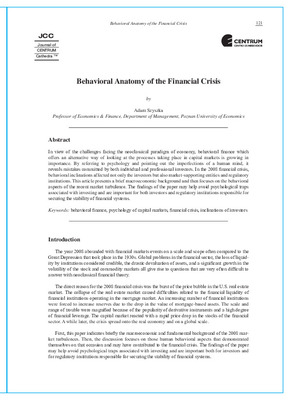| dc.contributor.author | Szyszka, Adam | |
| dc.date.accessioned | 2023-07-21T19:18:13Z | |
| dc.date.available | 2023-07-21T19:18:13Z | |
| dc.date.issued | 2010 | |
| dc.identifier.uri | https://repositorio.pucp.edu.pe/index/handle/123456789/194784 | |
| dc.description.abstract | In view of the challenges facing the neoclassical paradigm of economy, behavioral finance which offers an alternative way of looking at the processes taking place in capital markets is growing in importance. By referring to psychology and pointing out the imperfections of a human mind, it reveals mistakes committed by both individual and professional investors. In the 2008 financial crisis, behavioral inclinations affected not only the investors but also market-supporting entities and regulatory institutions. This article presents a brief macroeconomic background and then focuses on the behavioral aspects of the recent market turbulence. The findings of the paper may help avoid psychological traps associated with investing and are important for both investors and regulatory institutions responsible for securing the stability of financial systems. | en_US |
| dc.language.iso | eng | |
| dc.publisher | Pontificia Universidad Católica del Perú. CENTRUM | |
| dc.relation.ispartof | urn:issn:1851-6599 | |
| dc.rights | info:eu-repo/semantics/openAccess | es_ES |
| dc.rights.uri | http://creativecommons.org/licenses/by/4.0 | * |
| dc.source | Journal of CENTRUM Cathedra, Vol. 3, Issue 2 | |
| dc.subject | Behavioral finance | en_US |
| dc.subject | Financial crisis | en_US |
| dc.subject | Inclinations of investors | en_US |
| dc.subject | Psychology of capital markets | en_US |
| dc.title | Behavioral Anatomy of the Financial Crisis | en_US |
| dc.type | info:eu-repo/semantics/article | |
| dc.type.other | Artículo | |
| dc.subject.ocde | https://purl.org/pe-repo/ocde/ford#5.02.04 | |
| dc.publisher.country | PE | |


